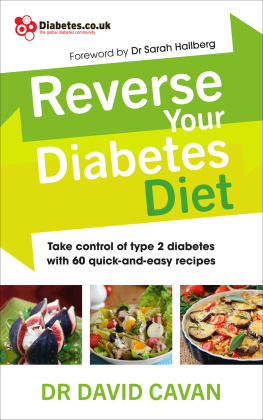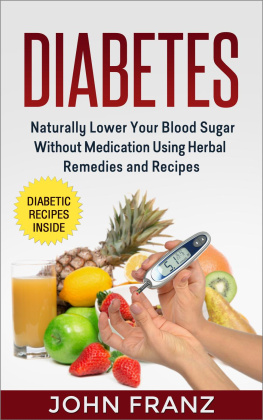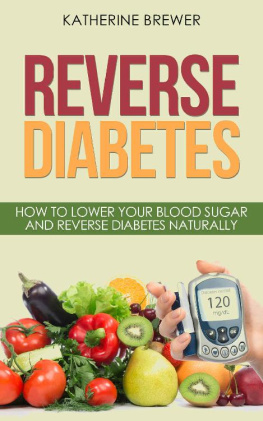CONTENTS

INTRODUCTION
O ver the last decade, dietary advice for diabetes has undergone a bit of a revolution. This new thinking is part of a larger, more intuitive approach to managing diabetes. Diabetes is a condition in which your blood glucose levels are abnormally high. The aim of diabetes management is to keep blood glucose within an optimal range and prevent complications. With guidance from your diabetes team, this can be achieved through healthy eating, exercise, maintaining a healthy weight and medication, if required. People with diabetes should eat a diet that is low in saturated fat, contains no added sugar or salt, and includes plenty of fruits and vegetables. The right amount of carbohydrate foods, such as bread, potatoes, cereals, pasta and rice, is also important. Here is an overview of the key nutrients a person with diabetes should consume.
sugar
People with diabetes dont need to avoid sugar completely. Sugar can be included as jam on some high-fiber toast or honey on oats as part of a healthy meal. However, candy or soft drinks that contain mostly added sugar are not recommended unless for treatment of hypoglycemia (low blood glucose). Unlike sugar, artificial sweeteners, such as aspartame, do not affect blood glucose levels. Use them to sweeten foods after cooking or to add to drinks. If you regularly use artificial sweeteners, choose a variety of different types.
carbohydrates
The bodys main source of energy is carbohydrate. Everyones carbohydrate needs are different but these foods should provide approximately half of your food intake for the day.
Carbohydrate foods contain either added sugar or natural sugars. Carbohydrates that contain natural sugars include fruit and fruit products, milk and yogurt, grain and cereal products and starchy vegetables such as potatoes, sweet potatoes and corn. Added sugars are found in candies, soft drinks, chocolate, cakes and cookies.
Carbohydrate foods are broken down in the body into sugars and, finally, to glucose. These foods have the most impact on your blood glucose levels of any foods. Eating carbohydrate foods regularly throughout the day will fuel your body and also help to keep blood glucose levels steady. Whole-grain cereals and breads, sweet potatoes and rolled oats are particularly recommended. Your dietitian can advise you how much carbohydrate to eat and when.
fatty foods
Fats are a class of organic chemicals that scientists refer to as fatty acids. When digested, they produce nearly double the energy of the same amount of carbohydrate or protein. Fat is only a problem when you eat too much of it and especially of the less healthy type. Fat molecules are stored in your body and this can result in weight gain. Carrying too much weight can impair the action of insulin and therefore cause higher than normal blood glucose levels. The build-up of fat-related molecules in your bloodstream is bad for your heart and circulatory system.
As with carbohydrates, it is wrong to say that all forms of fat are bad. There are three main types of fats, and two of these offer health benefits, so consider adding them to your dietin appropriate amounts.
Fats that are in liquid form at room temperature (primarily plant oils, such as corn, olive or canola oil) are split into two categories: polyunsaturated and monounsaturated. Both have benefits, but the latter are best for you. There is evidence that monounsaturated fat raises your HDL (good) cholesterol, which is important for people with diabetes because they have an increased risk of heart disease. Monounsaturated fat also has been shown to reduce insulin resistance.
Then there are the fish oils, or omega-3 fatty acids. These are essential to the body and are found in oily fish such as tuna, salmon, herring, mackerel, trout and sardines. Research shows that eating oily fish as part of a healthy lifestyle can help to lower the risks of heart disease. You should consume oily fish at least twice a week.
The type of fat that is least healthy for you is known as saturated fat and is solid at room temperature. Primarily, this means butter, cheese and the fat on meat. It also includes coconut and palm oil. Saturated fat has the most detrimental effect on your blood cholesterol, which in turn makes you more prone to certain diseases. It is therefore best to avoid or limit the amount of saturated fats you eat.
Trans fatty acids are a result of how some fats and oils are processed. They are generally found in manufactured foods such as cookies and cakes. Studies show that these fats act like saturated fats and can raise your blood cholesterol levels, so it is important to avoid foods that show hydrogenated vegetable oils at the top of the ingredients list.
salt
Eating too much salt is linked with high blood pressure, so it is advisable to cut down on salt intake in order to reduce the risk of heart disease. According to the governments Dietary Guidelines for Americans, 2010, people with diabetes should only consume 1,500 mg of salt per day. Most Americans consume more than twice that amount. If you consume a lot of processed meals and snacks, it is very likely that you are taking in far more salt than you need.
How to cut down on salt
Measure the amount of salt you add in cooking and gradually reduce the amount. You will soon get used to eating less salt.
Avoid adding salt at the table.
Experiment with dried and fresh herbs and freshly ground spices instead.
Replace salt-rich foods with low-salt products.
For varied flavors, try lime juice, balsamic vinegar and chili sauce.
Read food labels carefully: Salt may appear as sodium, sodium chloride, bicarbonate of soda or monosodium glutamate.
Cut down on salty foods such as chips, salted nuts, savory crackers and pretzels.
Salted and smoked foods such as bacon, sausages, smoked fish, some canned fish and other processed convenience foods are often loaded with salt.
Whenever possible, eat fresh fish, meats and vegetables; they contain only a small amount of naturally occurring salt.

A NOTE ABOUT THE RECIPES
The recipes in this book are suitable for people with diabetes. Each recipe includes a thorough analysis of key nutrients, including calories, protein, fat (including saturated fat), carbohydrates (including sugar), fiber and sodium. Note that foods that are included in the serving suggestions or that are optional are not included in the nutritional analysis.

SERVES
fruit smoothie
SERVES: 2
PREPARATION: 5
MINUTES COOKING: NONE
1 cup (250 ml) low-fat milk
1 ripe banana or mango, peeled and cut into chunks
1/4 cup (50 g) fresh or frozen blueberries or strawberries
1 teaspoon (5 ml) honey, or to taste
Combine all the ingredients in a blender and blend until smooth.
















